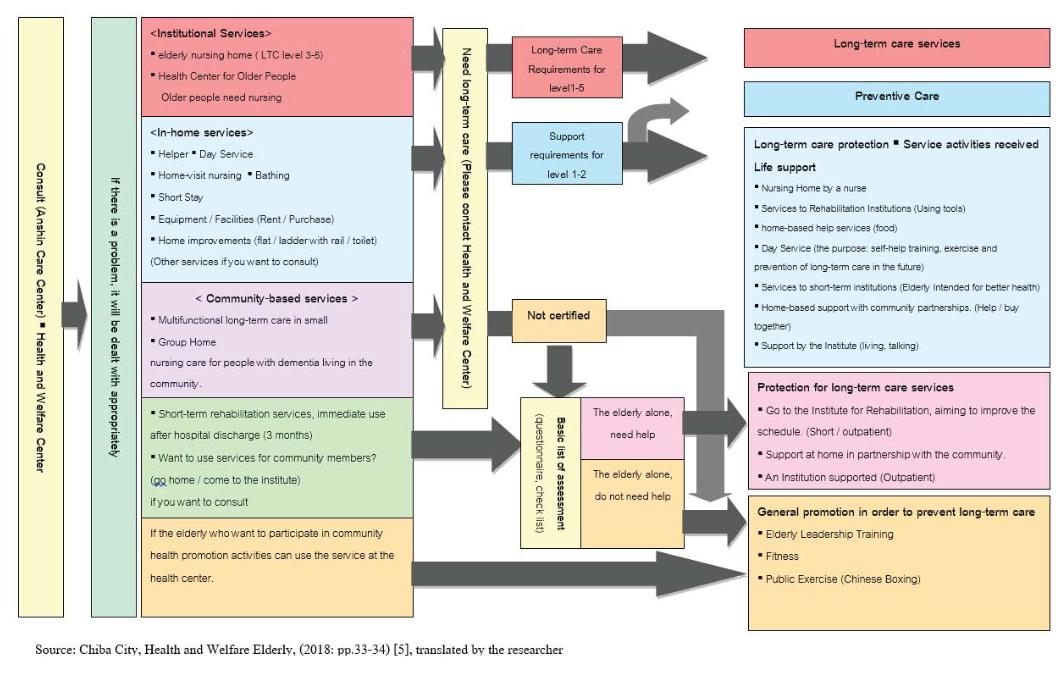Long-term care (LTC) system for the elderly in Japan
Main Article Content
Abstract
This qualitative research aims to study long-term care (LTC) system for the elderly in Japan, it is using in-depth interviews to collect data from government and related private sectors, including the Health and Welfare Center (Wakaba), Shukutoku Kyoseien Institute and Shalom’s Young Leaves Institution. The findings are: 1) The target group under LTC insurance is divided into 2 categories: Category 1: people aged 65 or over who request care or support services for whatever reason, Category 2: people aged 40-64 who suffer from specified 16 diseases, caused by aging. 2) Types of long-term care services included: (1) LTC requirements for levels 1-5 (2) Support requirements protection for levels 1-2 (3) Not certified; people who are still self-help, can get health promotion services for LTC preventive care in general. 3) Strong points and weak points: Strong points are (1) All forms of long-term care are similar but differ according to individual elderly situation (2) Co-payment between the government and the service users, who pays only 10-20% of their income. (3) Community-based services where people in the community participate in providing care services for the elderly to reduce hospital or institution costs, and keeping the elderly close to their family. (4) Services provision limited according to the classification of physical and mental conditions approved by the board. A Weak point is inadequate number of LTC workers to perform LTC services.
Article Details
References
United nations, Department of economic and social affairs, Population division, World population prospects the 2017 revision, Key findings and advance tables. Working Paper (2019) 19.
UN population division. World population prospects 2010 revision population database, (2018). Available from: http://esa.un.og/unpd/wpp/index.htm
Department of older persons. Main documents and resolutions of the National Elderly Assembly. “How will the elderly society build the power to enter the ASEAN community?”. Ministry of Social Development and Human Security (2558) 1.
Foundation for Thai gerontology research and development institute (TGRI) and institute for population and social research, Mahidol University. Thai elderly situation, 2015. Bangkok: Amarin Printing and Publishing Public Company Limited (2016) 7.
Chiba City, Health and welfare elderly, Summary of health and welfare for the elderly 30(2018) 33-36.
World health organization. World report on ageing and health. Geneva (2015).
T. Asada, Prevalence of dementia in japan , Past, present andfuture. Rinsho (2012).
G. Damiani, V. Farelli, A. Anselmi, L. Sicuro, A. Solipaca, A.Burgio, D. F. Iezzi, W. Ricciardi, Patterns of long term care in 29 european countries, evidence from an exploratory study. BMC Health Services Research. 11(2011) 316.
American Association for retired persons public policy institute, European experience with Long Term Care.France, the netherlands, Norway and The United Kingdom. 2006, (2018), Available from: http://www.aarp.org/research/international/report/leadershipstudyreports.html.
E. Schulz, The long term care system in Denmark. [European network of economic policy research institute, Research report no. 73]. DIW Berlin (Deutsches Institut fuer Wirtschaft-forschung, 2010, (2018), Available from: http://www.ancienlongtermcare.eu/node/27.Google Scholar.
I. Ayumi, I. Tomoaki, S. Tomohiro and Y. M. Noriko. Combinations of longterm care insurance services and associated factors in Japan: a classification tree model. Igarashi et al. BMC Health Services Research 2014, (2014), Available from: http://www.biomedcentral.com/1472-6963/14/382


